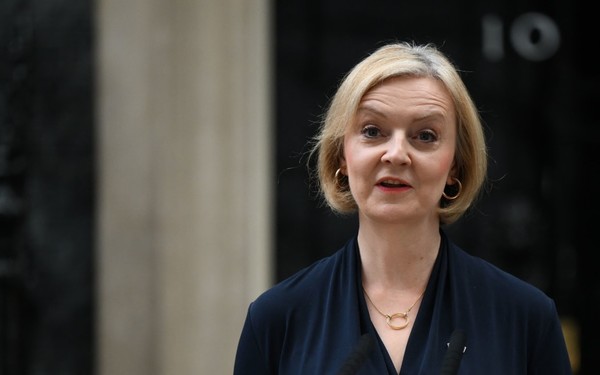The highest office of the UK has been held by Conservative leaders since 2010, each of whom have resigned from political turmoil. Most recently, financial matters have come into limelight with Liz Truss resigning from a whirlwind six-week term. In this Spotlight, we discuss the missteps that led to Truss's resignation and the challenges faced by the new Prime Minister, Rishi Sunak.
The Tories are going through prime ministers like Kleenex. With Liz Truss stepping down, the record is set once again as she becomes the shortest-serving prime minister in Britain’s history. The reason for Truss's failure seems to break down into three: a lack of diverse viewpoints within Truss’s team, an irresponsible economic agenda, and a revolt against Truss within her party. Launched into her tenure two days before Queen Elizabeth II’s death in the midst of a cost-of-living, gas, and energy crisis, Truss had a lot on her plate –– but even so, her short run was at best clumsy, and at worst, disastrous.

“We set out a vision for a low-tax, high-growth economy that would take advantage of the freedoms of Brexit,” Truss stated outside Downing Street in London on October 20, only 44 days after she was appointed as Prime Minister on September 10. “I recognize though, given the situation, I cannot deliver the mandate on which I was elected by the Conservative Party. I have therefore spoken to His Majesty the King to notify him that I am resigning as leader of the Conservative Party.”
From the onset of her career as Prime Minister, Truss was no stranger to disapproval. Truss was named leader of the Conservative Party following the resignation of Boris Johnson over Rishi Sunak in a short leadership contest, which meant that her service was determined by 81,326 Conservative party members instead of the majority of the voting British public. The reception to her appointment was thus mixed, poll statistics of satisfaction and expectations plummeting much below the average of previous UK prime ministers. Moreover, Truss was vilified by the working class for “selling herself” to the rank of party members prior to her designation by bowing down to their policies instead of representing the whole population. Truss’s pattern of streamlining political opinion continued when she was requested by the Queen to form a new administration, where Truss was widely faulted among critics for limiting her pool of political talent to those who aligned themselves with her own ideologies. In retrospect, it seems likely that lack of diverse opinions and undiscerning members may have been a factor resulting in various missteps undertaken by her administration.
Truss made her most fatal mistake on September 23, when her finance minister Kwasi Kwarteng announced Britain’s new economic strategy of slashing taxes for the most lucrative corporations and highest earners. From her plan of 30 billion GBP of unfunded tax cuts (which was already treading a tightrope), her team increased the cuts to an unachievable 110 billion GBP. Considering the UK’s total annual tax revenue is 1,000 GBP, critics believed it was impossible for the tax cuts to be stimulatory and their negative impacts to be transient. Additionally, to compensate for the massive rupture in state revenues, Truss and Kwarteng put forward a large borrowing scheme to finance tax cuts. This news was not well received by a country in the middle of a cost-of-living crisis and unstable economy caused by the Russo-Ukrainian War. Economic uncertainty caused business and consumer confidence to crash. Straight after the announcement, the British pound tanked. In a frenzy, the UK’s central bank hiked interest and mortgage payment rates which kickstarted an inflationary spiral.
Unsurprisingly, Truss became very unpopular — not only among the British public but also within the Cabinet and the rest of the Conservative community. Many proletariat voters who were initially attracted to the Conservatives during Brexit became frustrated that the party’s economic shift only benefited the financially affluent. Other members of the public were just as dissatisfied under the effects of worsening cost-of-living and energy crisis. Tory Members of Parliament (MPs) were quick to denounce Truss, realizing that her tenure may negatively affect the next general election. During Truss’s meeting with Sir Graham Stuart Brady, Chairman of the 1922 Committee, Conservative MPs without ministerial positions submitted “Letters of No Confidence” to the current prime minister. During the hour-long meeting, 17 Conservative MPs publicly called Truss to resign. Soon after, Truss gave her resignation announcement.
Truss had a tumultuous six-week term, faced by adversities in world crises, and adversaries in her own party. Regardless, as Prime Minister, she bore the responsibility to follow through on her promise to “deliver” on the economy, healthcare system, and gas and energy crisis, none of which she ameliorated. Ergo, widespread hatred from the public as well as her cabinet pressured her to step down. However, it may also be important to consider less obvious contributing factors that were present even before Truss came to power. The Conservative Party’s election contest has endured criticism for the way it elects its leaders — Truss, for example, landed in the final round almost by default. Then, was Truss’s downfall wholly her fault? Or is her rule symptomatic of a larger problem in UK politics?

